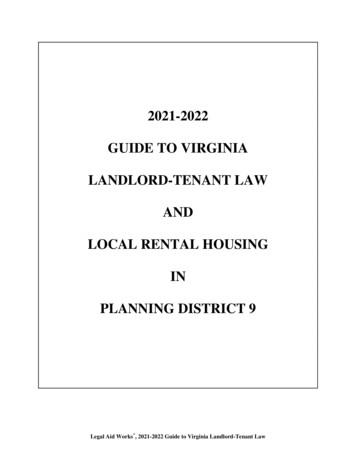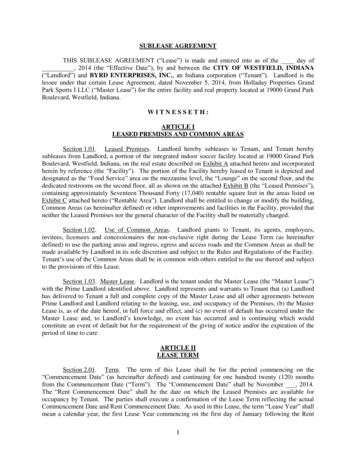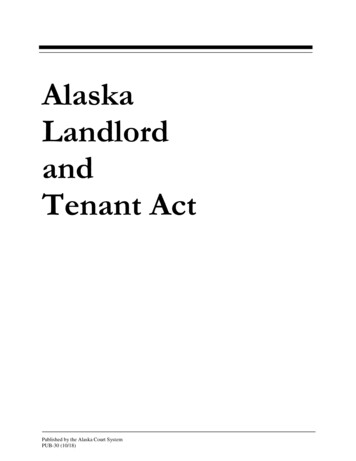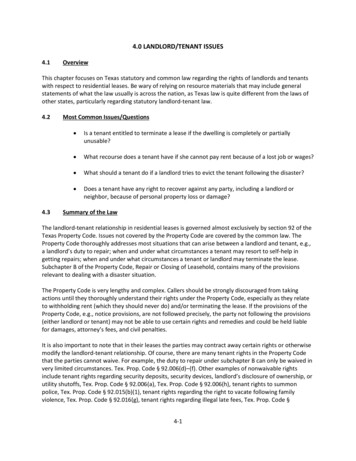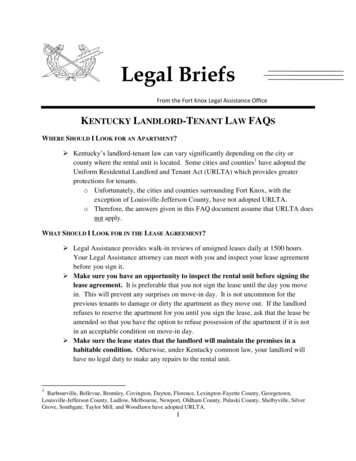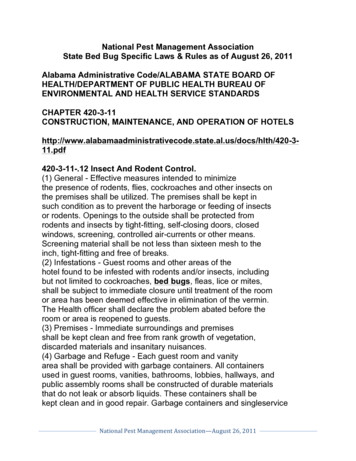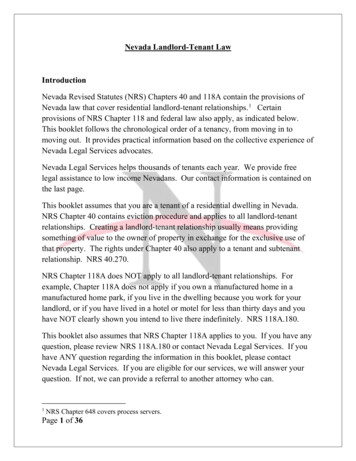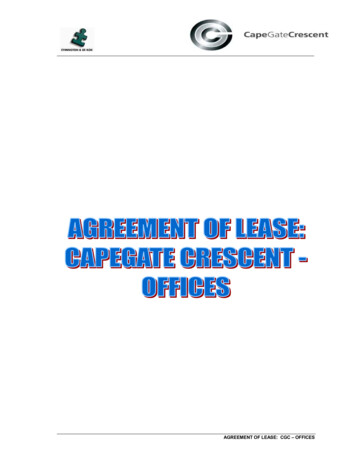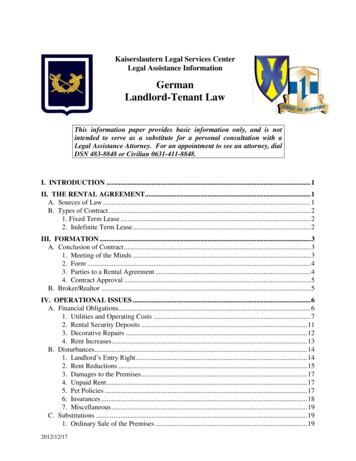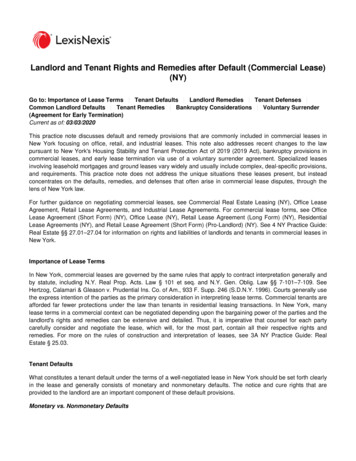
Transcription
Landlord and Tenant Rights and Remedies after Default (Commercial Lease)(NY)Go to: Importance of Lease Terms Tenant Defaults Landlord Remedies Tenant Defenses Common Landlord Defaults Tenant Remedies Bankruptcy Considerations Voluntary Surrender(Agreement for Early Termination)Current as of: 03/03/2020This practice note discusses default and remedy provisions that are commonly included in commercial leases inNew York focusing on office, retail, and industrial leases. This note also addresses recent changes to the lawpursuant to New York's Housing Stability and Tenant Protection Act of 2019 (2019 Act), bankruptcy provisions incommercial leases, and early lease termination via use of a voluntary surrender agreement. Specialized leasesinvolving leasehold mortgages and ground leases vary widely and usually include complex, deal-specific provisions,and requirements. This practice note does not address the unique situations these leases present, but insteadconcentrates on the defaults, remedies, and defenses that often arise in commercial lease disputes, through thelens of New York law.For further guidance on negotiating commercial leases, see Commercial Real Estate Leasing (NY), Office LeaseAgreement, Retail Lease Agreements, and Industrial Lease Agreements. For commercial lease forms, see OfficeLease Agreement (Short Form) (NY), Office Lease (NY), Retail Lease Agreement (Long Form) (NY), ResidentialLease Agreements (NY), and Retail Lease Agreement (Short Form) (Pro-Landlord) (NY). See 4 NY Practice Guide:Real Estate §§ 27.01–27.04 for information on rights and liabilities of landlords and tenants in commercial leases inNew York.Importance of Lease TermsIn New York, commercial leases are governed by the same rules that apply to contract interpretation generally andby statute, including N.Y. Real Prop. Acts. Law § 101 et seq. and N.Y. Gen. Oblig. Law §§ 7-101–7-109. SeeHertzog, Calamari & Gleason v. Prudential Ins. Co. of Am., 933 F. Supp. 246 (S.D.N.Y. 1996). Courts generally usethe express intention of the parties as the primary consideration in interpreting lease terms. Commercial tenants areafforded far fewer protections under the law than tenants in residential leasing transactions. In New York, manylease terms in a commercial context can be negotiated depending upon the bargaining power of the parties and thelandlord's rights and remedies can be extensive and detailed. Thus, it is imperative that counsel for each partycarefully consider and negotiate the lease, which will, for the most part, contain all their respective rights andremedies. For more on the rules of construction and interpretation of leases, see 3A NY Practice Guide: RealEstate § 25.03.Tenant DefaultsWhat constitutes a tenant default under the terms of a well-negotiated lease in New York should be set forth clearlyin the lease and generally consists of monetary and nonmonetary defaults. The notice and cure rights that areprovided to the landlord are an important component of these default provisions.Monetary vs. Nonmonetary Defaults
Landlord and Tenant Rights and Remedies after Default (Commercial Lease) (NY)Monetary defaults result from the tenant's failure to timely pay amounts owed under the lease. These amountsinclude not only base rent but also additional rent, percentage rent (common in retail leases), and common areamaintenance fees. Most tenant defaults are monetary defaults.A nonmonetary default is any default under the terms of the lease other than a monetary default. Commonnonmonetary defaults include the failure of the tenant to take possession, holding over, failure to maintain operatinghours, destruction of the landlord's property, and the breach of a covenant or rule set forth in the lease.Notice and Cure Rights and ObligationsHistorically, commercial tenants in New York have not had a statutory right to notice of a lease default. Likewise,there is no general obligation imposed on the landlord to provide a commercial tenant with the right to cure adefault. That said, a revision N.Y. Real Prop. Law § 235-e(d) brought about by the 2019 Act states that any “lessor”that does not receive payment of rent within five days of the date specified in the lease agreement must send thetenant, by certified mail, a written notice stating that the landlord has not received payment. If a landlord fails tosend this notice prior to commencing a proceeding based upon the failure to pay rent, the tenant can raise theomission as an affirmative defense. This subsection does not specifically indicate that it is limited to residentialtenancies. However, when considered fully, N.Y. Real Prop. Law § 235-e appears to deal exclusively withresidential tenancies and it seems unlikely that the notice requirement was intended to apply to commercialtenancies. Even so, some commentators have suggested that until this ambiguity is addressed, the best practice isfor a commercial landlord to send a notice by certified mail when a tenant fails to pay rent within five days of its duedate.In addition, commercial leases in New York generally include some requirement that the landlord provide the tenantwith notice of default and the opportunity to cure. For monetary defaults, a 5 to 10-day cure period following noticeis common (often, this right is limited to one occurrence per 12-month period). For nonmonetary defaults, cureperiods are often set at 30 days following notice. Counsel for both the landlord and the tenant should take care tofully negotiate both notice and cure rights and obligations and clearly set out these terms in the lease.Extension of Cure Period for Nonmonetary Default (Yellowstone Injunction)Since 1968, a commercial tenant in New York who has received a notice of nonmonetary default has benefittedfrom a unique tool commonly referred to as a “Yellowstone injunction.” However, a 2019 ruling by the New YorkCourt of Appeals, has thrown the future viability of Yellowstone injunctions into doubt.A Yellowstone injunction allows a commercial tenant who has been served with a notice to cure an alleged leasedefault to toll the period for curing the default while seeking a declaratory judgment on the question of whether adefault exists. Even if the tenant receives an adverse decision on the merits, the cure period remains tolled so thetenant can later cure the default and avoid losing its lease. First Nat'l Stores, Inc. v. Yellowstone Shopping Ctr., Inc.,290 N.Y.S.2d 721 (1968).To obtain the injunction, the tenant must show that: It holds a valuable commercial lease. It has received a notice of default, notice to cure, or concrete threat of termination of the lease from thelandlord. It requested injunctive relief prior to the termination of the lease.—and— It is ready and willing to cure the alleged default, by any means short of vacating the premise, if it is ultimatelydetermined that the tenant is in default.In 159 MP Corp. v. Redbridge Bedford, LLC, the New York Court of Appeals ruled that a commercial tenant waivesthe right to seek a Yellowstone injunction if its lease contains a specific waiver of the right to bring a declaratoryjudgment action. 33 N.Y.3d 353 (2019). Assuming that most landlords have the leverage to include a waiver ofdeclaratory judgment in their leases, the Yellowstone injunction will no longer be widely available to commercialPage 2 of 13
Landlord and Tenant Rights and Remedies after Default (Commercial Lease) (NY)tenants. This will make it harder for tenants to save their leases if the landlord attempts to recapture the space for alease infraction, even one that is trivial or technical. A tenant may now have to choose between curing the defaultwithin the required time period, even if the tenant has legitimate grounds to contest the default and the cost to cureis very high or taking its chances by letting the cure period expire and hoping it can prevail in a summary processproceeding.Landlord RemediesThe remedies available to a landlord following the tenant's default are typically determined by the terms of thelease. These remedies must be enforced in accordance with New York law. Beyond looking to the tenant's securitydeposit and any lease guarantors, the use of a summary proceeding to obtain possession of the leased premises isthe most commonly used remedy in New York.Use of Security DepositMost commercial leases in New York require the tenant to deposit funds with the landlord or provide a letter ofcredit as security for its performance under lease. The lease's treatment of the security deposit is open tonegotiation, but, generally, the security deposit can be used as follows: As an interim remedy for nonmaterial breaches. If a default does not rise to a level that prompts thelandlord to terminate the lease or when recovery of a relatively small amount of money does not justify thecost of litigation, the landlord may cure the default by using the security deposit. If the security deposit isused for this purpose during the term, most leases require the tenant to restore the security deposit to itsprevious amount after written demand by the landlord. As liquidated damages. If the lease provides, in circumstances when the actual damages are difficult tomeasure, the landlord may retain the entire security deposit as its sole remedy upon a tenant default.However, such a clause may be held invalid as a penalty if the damages are easy to ascertain or thesecurity deposit has been treated as an advance payment of rent at the end of the term. At end of term. Most commercial leases provide that the landlord may also use the security deposit to correctunfulfilled conditions or obligations at the end of the lease term after the tenant has vacated the premises.In this case, leases usually provide that any unused portion of the security deposit be returned to thetenant.For more on security deposits, see Commercial Real Estate Leasing (NY) and the relevant sections in Office LeaseAgreements, Residential Lease Agreements, and Industrial Lease Agreements. See also Current Leasing Law andTechniques—Forms § 3D.29 and 31 Current Legal Forms with Tax Analysis § 23.29 (6).Enforcement of GuarantyWhether or not a guaranty is required in a lease transaction is a negotiated business term that typically depends onthe financial strength of the tenant. If there is a lease guaranty, the landlord may pursue enforcement according toits terms, which commonly include the right to join the guarantor(s) in a legal action against a tenant after default,subject to the limitations of the guaranty.If the guaranty is limited to the payment of rent, the landlord may use N.Y. C.P.L.R. Law § 3213 to file an immediatemotion for summary judgment instead of a complaint. Royal Equities Operating, LLC v. Rubin, 62 N.Y.S.3d 337(App. Div. 2017). This procedure can allow the landlord to avoid a lengthy and costly trial. However, N.Y. C.P.L.R.Law § 3213 may only be used in an action based “upon an instrument for the payment of money only.” Thus, itcannot be used when the guaranty extends to the performance of other lease covenants and obligations. TimesSquare Assocs. v. Grayson, 333 N.Y.S.2d 155 (App. Div. 1972). When permitted under the lease, Section 3213 canbe used to collect accelerated rent from a guarantor. See Royal Equities Operating, LLC v. Rubin, 62 N.Y.S.3d 337(App. Div. 2017).Page 3 of 13
Landlord and Tenant Rights and Remedies after Default (Commercial Lease) (NY)For more on commercial lease guaranties, see Good Guy Guaranties (NY), Guaranty of an Office LeaseAgreement, Guaranty of a Retail Lease Agreement, and Guaranty of an Industrial Lease Agreement.For forms, see Guaranty of an Industrial Lease Agreement; Guaranty of an Office Lease Agreement; Guaranty of aRetail Lease Agreement; Guaranty (Personal Guaranty, Retail Lease); Limited Guaranty of Lease (Retail Lease);and Guaranty (Guaranty by Corporation, Retail Lease).Summary Proceeding to Recover PossessionSummary proceedings aim to provide landlords in New York with a streamlined process for obtaining possession ofleased premises following a tenant default. This process is set forth in Article 7 of the N.Y. Real Prop. Acts. Law.JurisdictionAlthough summary proceedings may be brought in either supreme court or civil court, they are almost alwaysbrought in civil court because the process is much faster there. Where the only issues involved are the rights of theparties to possession of the premises and claims for rent (or abatement of rent), the civil court will have fulljurisdiction. Where rent is sought within the context of a summary proceeding, there is no maximum limit as to theamount in controversy and the normal 25,000 limit does not apply. NY CLS UDCA § 204; NY CLS NYC Civil CtAct § 204. The parties should not use the supreme court unless the civil court (by reason of its limited equitablejurisdiction) cannot grant appropriate relief.When a landlord has brought, or is about to bring, a summary proceeding in civil court, the tenant frequently bringsan action in supreme court seeking either an injunction against the prosecution of a summary proceeding orconsolidation of the civil court and supreme court actions. Consolidation, however, is not permitted unless it can beshown that the civil court cannot afford complete relief between the parties. Lun Far Co. v. Aylesbury, 338 N.Y.S.2d84 (1st Dept. 1972). That said, the supreme court is the proper forum when a tenant seeks a Yellowstone injunctionand some landlords in this situation prefer to counterclaim with an ejectment action rather than bring a new action incivil court to pursue a summary proceeding.Grounds for Summary ProceedingA landlord may bring a summary process proceeding under the following circumstances: The tenant holds over (this includes both a holdover following the expiration of the lease term and thetermination of the lease by the landlord for a nonmonetary default). The tenant defaults in the payment of rent pursuant to the lease terms and either a demand has been madefor rent or a 14-day written notice requiring the possession of the premises has been served. If required to do so in the lease, the tenant in a city fails to pay taxes or assessments for more than 60 daysafter they become due and payable and a three-day written notice (requiring either the payment thereof(with interest and penalty) or the possession of the premises) has been served. Under a lease for a term of three years or less, the tenant takes the benefit of an insolvency statute or hasbeen adjudicated a bankrupt. The premises are used or occupied for illegal business. The tenant, in a city having a population of one million or more, disables an installed smoke or fire detectorwithout permission.N.Y. Real Prop. Acts. Law § 711.Most summary proceedings based on Section 711 in commercial tenancies are holdover and nonpaymentproceedings. These proceedings are discussed in detail below.Holdover ProceedingsPage 4 of 13
Landlord and Tenant Rights and Remedies after Default (Commercial Lease) (NY)A tenant becomes a holdover tenant when it remains in occupancy of the leased premises after (1) expiration ortermination of the lease pursuant to its terms or (2) termination of the lease by the landlord due to a default. Thelandlord must be careful not to convert a holdover tenant into a tenant at will by taking actions that may be seen asacquiescing to the tenant's holdover (such as accepting the payment of rent). N.Y. Real Prop. Acts Law § 232-c.Note that if the tenant is deemed a month-to-month tenant, the tenancy must be terminated pursuant to N.Y. RealProp. Law § 232-a (if the premises are in New York City) or N.Y. Real Prop. Law § 232-b (if the premises areoutside of New York City). For sample termination notices, see Notice to Terminate Month-to Month Tenancy (NewYork City) and Notice to Terminate Month-to Month Tenancy (Commercial Tenancy) (NY - Outside New York City).Nonpayment ProceedingsN.Y. Real Prop. Acts. Law § 711(2) provides that a nonpayment proceeding may be maintained when the tenanthas defaulted in the payment of rent. In a nonpayment proceeding, the landlord typically seeks both the recovery ofrent owed and possession of the premises.Notice Requirements for Summary ProceedingIn a nonpayment proceeding, the landlord must give 14 days' written notice before bringing a summary proceeding.N.Y. Real Prop. Acts. Law § 711(2). (The 2019 Law increased the required notice from 3 to 14 days.) For a samplenotice, see 14-day Demand for Payment of Rent or Possession (Eviction) (NY).In a commercial holdover proceeding where there has been no conduct that would create a month-to-monthtenancy or give rise to a right of further occupancy, no notice (beyond what may be required under the lease) isnecessary before bringing an action.The statutory timelines prevail over conflicting lease terms unless the lease default and notice provisionsspecifically enumerate a notice requirement for a summary proceeding. See Retail Prop. Tr. v. Charles David ofCal., 977 N.Y.S.2d 670 (Dist. Ct. 2013). However, there are exceptions to this rule. For example, where the leaseexpressly stated that the service of a notice is required before the commencement of “any proceeding,” the courtfound that the provision served to lengthen the statutory time period. Hendrickson v. Lexington Oil Co., 340N.Y.S.2d 963 (App. Div. 1973).Commencement of Summary ProceedingAfter all required notices are given, the landlord may begin the summary proceeding by serving a notice of petition(similar to a summons) and a petition (similar to a complaint) on the tenant. The notice may be issued by a judge,clerk of court, or attorney, except that in New York City, it may not be issued by an attorney. N.Y. Real Prop. Acts.Law § 701; NY CLS NYC Civil Ct Act § 401.N.Y. Real Prop. Acts. Law § 741 requires the petition to be verified and contain the following minimum information: The name(s) of the parties and their respective interests (landlord/tenant) A description of the premises A description of facts on which the proceeding is based (i.e., rent arrears and periods or holdover)—and— The relief soughtThe notice of petition must specify the time and place of the hearing on the petition. If the proceeding is fornonpayment of rent, Section 732 requires that the notice of petition be returnable before the clerk within 10 daysafter its service. (Note that prior to enactment of the 2019 Law, the tenant had only five days to answer.)If the tenant answers, the clerk will fix a date for a hearing within no less than three and no more than eight days. Ifthe tenant does not answer within the days, the judge will enter a judgment for the landlord. If the tenant answers,the matter will proceed to trial. N.Y. Real Prop. Acts. Law § 732. In a nonpayment proceeding, the tenant's answermay contain any legal or equitable defense as well as counterclaims. N.Y. Real Prop. Acts. Law § 743. However,lease waivers of counterclaims in a summary proceeding are enforceable. Chemical Bank New York Trust Co. v.Page 5 of 13
Landlord and Tenant Rights and Remedies after Default (Commercial Lease) (NY)Batter, 31 A.D.2d 802, 297 N.Y.S.2d 363 (1st Dept. 1969). Likewise, a provision in a lease waiving in advance ajury trial in the event of litigation between the landlord and tenant is enforceable. Waterside Holding Corp. v. Lask,253 N.Y.S. 183 (App. Div. 1931).Suit for Collection of RentMost landlords that bring a summary nonpayment proceeding also seek past due rent and civil court is the preferredcourt for landlord-tenant disputes. However, landlords also have the option to collect past due rent through a suitbased on breach of contract without going through the eviction process. This is a plenary action brought in supremecourt. Discovery is permitted and the tenant may assert defenses and bring counterclaims, and such an action cantake much longer than seeking rent in conjunction with a summary proceeding. For further guidance, see 4 NYPractice Guide: Real Estate § 31.02.Counsel for the landlord should ensure that the lease includes a provision giving the landlord the right to (1) recoverall rent and other sums up to the time of termination (or recovery of possession); (2) recover the cost ofimprovements made by landlord in connection with the lease; and (3) recapture of brokerage commissions, rentabatement, and/or concessions paid in conjunction with the lease.Accelerated RentThe landlord will want the lease to include a provision allowing the landlord to collect an amount equal to thebalance of the rent for the term as damages (known as rent acceleration). Rent acceleration is a contract remedybased on anticipatory breach of the lease by the tenant's failure to pay future installments of rent. In general, whena tenant is removed from the premises, the landlord-tenant relationship “ceases and the landlord may not recoverfrom the tenant, as rent, subsequent installments thereof for which the lease provides.” Int'l Publ'ns, Inc. v.Matchabelli, 184 N.E. 51 (N.Y. 1933). However, this does not prevent the landlord and tenant from contracting asthey please; therefore, if the lease provides that the obligation to pay rent survives the landlord's reentry onto thepremises upon the tenant's default, the landlord may bring a suit to recover accelerated rent. Id.If possible, the tenant should negotiate to limit the landlord's ability to accelerate rent under the lease. Commonlimitations include: Longer cure periods Acceleration limited to (1) demanding full rent upon default or (2) requiring the tenant to meet ongoingobligations Mitigation of damages requirement for the landlord Reduction of accelerated rent to present value (i.e., discount the aggregate amount by a negotiatedpercentage) Offset of accelerated rent by the amount of any rents the landlord receives from a replacement tenantIf the landlord agrees to any limitations on its ability to accelerate rent, it may require one or more of the following:(1) a larger security deposit, (2) a personal guaranty, and/or (3) a reduction of any tenant offset for rents receivedfrom a replacement tenant by the amount paid by the landlord to obtain the new tenant.For more on rent recovery and rent acceleration in New York, see 7 Warren's Weed New York Real Property §84.05.Landlord's Duty to Mitigate DamagesIn New York, a commercial real estate landlord has no duty to mitigate its damages. If a tenant under a commerciallease abandons the premises before expiration of the lease, the landlord has the option to do nothing, leaving thetenant responsible for the full rent due under the lease, or it may accept the tenant's surrender and reenter thepremises to relet the space directly, or it may notify the tenant that it is entering and reletting the premises for thePage 6 of 13
Landlord and Tenant Rights and Remedies after Default (Commercial Lease) (NY)tenant's benefit with the tenant to remain on the hook for the duration of its lease term. Holy Properties Ltd., L.P. v.Kenneth Cole Prods., 87 N.Y.2d 130 (1995). See also Wienecke v. Evans, 841 N.Y.S.2d 222 (Justice Ct. 2007).Other Landlord RemediesAction in EjectmentPrior to the enactment of the summary process statute, a landlord that wished to remove a defaulting tenant neededto bring a common-law action to recover real property (formerly known as an action in ejectment). This remedy isgoverned by Article 6 of the N.Y. Real Prop. Acts. Law and is still available; however, because it takes much longer,it is rarely used unless a summary process action is not available. See N.Y. Real Prop. Acts. Law § 601 et seq. and12 Warren's Weed New York Real Property § 129.05.Self-Help EvictionsIn New York, a landlord may use the remedy of peaceable reentry to regain possession of the leased premise incertain, very limited circumstances that meet the following four requirements: The lease reserves the landlord's right to reenter and regain possession of the premises upon the tenant'sdefault for nonpayment of rent. The landlord serves a demand for an approximate sum of rent owed on the tenant. The tenant is in default of its obligation to pay rent.—and— The entry does not breach the peace.Although this remedy is available to commercial landlords, its use is not recommended in most cases because itmay subject the landlord to liability as well as treble damages. See N.Y. Real Prop. Acts. Law § 853 and N. Main St.Bagel Corp. v. Duncan, 775 N.Y.S.2d 362 (App. Div. 2004). Given the simplicity and speed of the statutorysummary proceeding scheme, counsel for landlords should advise their clients to avoid self-help evictions.Abandoned Personal PropertyFollowing a tenant default and lease termination, it is common for a tenant to leave property behind when it vacatesthe premises. New York does not have a statute that regulates the way landlords must handle personal property leftbehind by a tenant. As an initial matter, the landlord should secure legal possession of the premises beforedisposing of the tenant's property. The landlord should then determine whether any of the tenant's personalproperty is a fixture (meaning it becomes part of the realty after annexation and thus the property of the landlord).See 7 Warren's Weed New York Real Property § 82.08 for more information on determining whether the tenant'sproperty can be considered to be a fixture. Given the absence of statutory guidelines for abandoned property inNew York, landlord's counsel should include provisions in the lease detailing what happens if the tenant leavespersonal property behind when it vacates the premises.Tenant DefensesDepending on its bargaining power, it may be difficult to negotiate provisions in a lease that provide viable defensesin response to the enforcement of remedies by the landlord. The defenses discussed below may be available in asummary proceeding.Actual EvictionAn actual eviction involves the wrongful physical expulsion of the tenant from the premises and can occur when thetenant is physically unable to enter the premises, or the owner changes the locks or padlocks the door. Fifth Ave.Bldg. Co. v. Kernochan, 117 N.E. 579 (1917)); Barash v. Pa. Terminal Real Estate Corp., 256 N.E.2d 707 (1970).The tenant may claim an actual partial eviction as a defense if the tenant is denied use of a portion of the premisesor of a right or service that was necessary for the tenant's use of the premises. For example, in Union City UnionPage 7 of 13
Landlord and Tenant Rights and Remedies after Default (Commercial Lease) (NY)Suit Co. v. Miller, 556 N.Y.S.2d 864 (App. Div. 1990), the tenant was denied the use of elevator service for its textilebusiness, in effect creating a partial actual eviction. For years, the recognized rule in New York was that the entirerent is abated when an actual partial eviction exists (see Fifth Ave. Bldg. Co. v. Kernochan, 117 N.E. 579 (1917)). In2012, the Court of Appeals recognized an exception to this rule when the impact on the tenant's use and enjoymentof the premises is “de minimis.” Eastside Exhibition Corp. v. 210 E. 86th St. Corp., N.E.2d 246, 249 (2012).The tenant does not need to vacate the premises to raise actual partial eviction as a defense (although the tenantthat remains in possession cannot bring an action for damages). Broadway-Spring Street Corp. v. Jack BerensExport Corp., 171 N.Y.S.2d 342 (N.Y. Mun. Ct. 1958).Constructive EvictionA tenant may claim constructive eviction where the landlord's failure to maintain the premises has resulted in thepremises being untenantable. Constructive eviction is similar to a violation of the warranty of habitability (which isnot available in a commercial context). The constructive eviction defense often involves a claim that deficientconditions in and services to the premises substantially interfere with the tenant's use of the premises. SeeManhattan Mansions v. Moe's Pizza, 561 N.Y.S.2d 331 (Civ. Ct. 1990).The tenant is required to abandon the premises to claim constructive eviction as a defense. However, some courtshave adopted the concept of a partial constructive eviction to circumvent this rule when a tenant raises constructiveeviction as a defense in a rent proceeding. See Bet Constr. Corp. v. New York, 410 N.Y.S.2d 524 (Sup. Ct. 1978).The tenant must abandon the portion of the premises for which the partial constructive eviction is claimed. Id. Notethat a claim of partial constructive eviction is only available as a defense in a rent proceeding brought by thelandlord rather than in an action brought by the tenant. Elkman v. Southgate Owners Corp., 649 N.Y.S.2d 138 (App.Div. 1996); Minjak Co. v. Randolph, 528 N.Y.S.2d 554 (App. Div. 1988).For more on the use of the defense of constructive eviction, see 4 NY Practice Guide: Real Estate § 27.02.Landlord's Acceptance of Rent or Other Delay in Enforcing Rights and RemediesPayment is a defense in a nonpayment proceeding, as is a written waiver by the landlord of the right to collect bymeans of a nonpayment proceeding or otherwise. N.Y. Real Prop. Acts. Law § 711(2). Acceptance of rent afterservice of a notice to cure and before commencement of a holdover summary proceeding can constitute a waiver.B.G. Smith Real Estate v. Byrne, 112 N.Y.S.2d 893 (App. Term 1st Dept. 1952). Likewise, acceptance of all rentowed after judgment and before execution of the warrant can avoid eviction. Walker v. Ribotsky, 275 A.D. 112, 88N.Y.S.2d 207 (1st Dept. 1949).Nonwaiver clauses in commercial leases are enforceable. Jefpaul Garage Corp. v. Presbyterian Hosp. in N.Y., 474N.Y.S.2d 458, 462 N.E.2d 1176 (1984). If the lease is silent, however, a classic tenant defense in an eviction actionis that the landlord's acts or omissions created a waiver of the default. The landlord should include the followingprovisions to protect itself from this tenant defense: No delay in the enforcement of any right or remedy will constitute a waiver of a tenant default or any of thelandlord'
default exists. Even if the tenant receives an adverse decision on the merits, the cure period remains tolled so the tenant can later cure the default and avoid losing its lease. First Nat'l Stores, Inc. v. Yellowstone Shopping Ctr., Inc., 290 N.Y.S.2d 721 (1968). To obtain the injunction, the tenant must show that:
